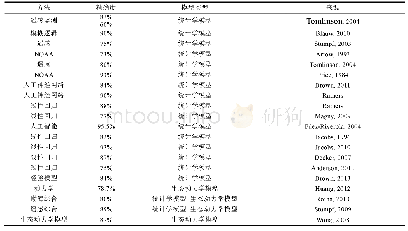《Table 1 Current indications for endoscopic ultrasonography-guided biliary drainage after failure of
 提示:宽带有限、当前游客访问压缩模式
提示:宽带有限、当前游客访问压缩模式
本系列图表出处文件名:随高清版一同展现
《Comprehensive review on EUS-guided biliary drainage》
GI:Gastrointestinal.
Endoscopic retrograde cholangiopancreatography(ERCP)with stent placement represents standard treatment for the management of benign and malignant biliary obstructions.Approximately 500000 ERCPs are performed annually in the United States alone with a failure rate that varies between 5%and 7%[1].ERCP-guided biliary drainage is performed by direct cannulation of the papilla under endoscopic vision via the duodenoscope with the assistance of radiological cholangiography.Once the biliary tract has been reached,the biliary drainage can be obtained with different devices and technique(with stent positioning)depending on the underlying disease.In light of this,the papilla must necessarily be endoscopically reachable.Therefore,reasons for failure depend mainly on whether the papilla is endoscopically accessible or not.In the first case,ampullary pathology,periampullary diverticulum,and ampullary neoplastic infiltration can cause failure.In the second case,benign(peptic stenosis)and malignant duodenal stenosis or postsurgical anatomy such as a gastrointestinal bariatric bypass,a Roux-en Y gastric bypass or a Billroth II gastroenterostomy may prevent the access to the papilla causing unsuccessful procedures(Table 1).
| 图表编号 | XD0058773700 严禁用于非法目的 |
|---|---|
| 绘制时间 | 2019.05.16 |
| 作者 | Raffaele Salerno、Sophia Elizabeth Campbell Davies、Nicolò Mezzina、Sandro Ardizzone |
| 绘制单位 | Gastroenterology and Digestive Endoscopy Unit,ASST Fatebenefratelli Sacco-Department of Biochemical and Clinical Sciences “L. Sacco”,University of Milan、Hospital Pharmacy,ASST Fatebenefratelli Sacco,Piazza Principessa Clotilde、Gastroenterology and Digesti |
| 更多格式 | 高清、无水印(增值服务) |
查看“Table 1 Current indications for endoscopic ultrasonography-guided biliary drainage after failure of endoscopic retrograd”的人还看了
-

- Table 5 Characteristics of enteroscope types used for endoscopic retrograde cholangiopancreatography





